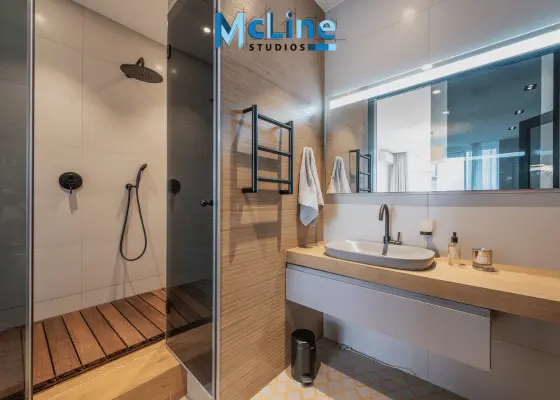Remodeling a bathroom can be a big job, but having detailed shop drawings can help make it go smoothly. These technical bathroom shop drawings act as a plan, showing contractors, architects, and homeowners everything that needs to be done.
A well-prepared set of bathroom shop drawings ensures that everyone is on the same page, minimizing costly mistakes, delays, and misunderstandings during the construction process.
Moving ahead, In this guide we’ll try to explain bathroom shop drawings and their fundamentals. We’ll also shed light on the elements and applications of bathroom shop drawings. So, let’s start.
What Are Bathroom Shop Drawings?
Bathroom shop drawings are detailed, technical illustrations that provide precise information about the design, dimensions, and construction of bathroom components.
These drawings are used by architects, contractors, and manufacturers to ensure that all elements of a bathroom project are built and installed correctly.

Elements Of Shop Drawings
Here are the key elements typically included in bathroom shop drawings:
- Plan Views: Overhead views showing the layout of the bathroom, including the placement of fixtures such as toilets, sinks, showers, bathtubs, and cabinets.
- Elevations: Vertical views of each wall in the bathroom, detailing the heights and relationships between different elements such as vanities, mirrors, and shelving.
- Sections: Cross-sectional views that provide a cut-through perspective of various components, showing how different parts fit together and their internal construction.
- Details: Close-up views of specific areas or components that require more precise information, such as the connections between fixtures, mounting details for accessories, or the profile of moldings and trims.
- Dimensions: Exact measurements for all components and their placement within the space. This ensures accurate construction and installation.
- Materials and Finishes: Specifications for the materials and finishes to be used, including information on tiles, countertops, cabinetry, hardware, and other elements.
- Plumbing and Electrical Layouts: Diagrams showing the routing and connection points for plumbing and electrical systems, including pipe sizes, fixture connections, wiring routes, and outlet placements.
- Fixtures and Fittings: Detailed information about the fixtures and fittings to be installed, including model numbers, manufacturers, and installation instructions.
Do We Need Shop Drawings For Bathroom?
Yes, Indeed. Bathroom shop drawings play a crucial role in the construction process, serving as detailed visual guides that communicate design intent and technical specifications to various stakeholders involved in the project.
These drawings provide a comprehensive overview of the bathroom layout, including dimensions, plumbing configurations, fixture placements, and materials to be used.
Their importance lies in several key aspects. Firstly, they help architects and designers ensure that their vision for the bathroom is accurately translated into the final built environment, allowing for precise planning and execution.
Secondly, shop drawings act as a communication tool between the design team, contractors, and suppliers, facilitating collaboration and minimizing errors or misunderstandings during construction.
Additionally, shop drawings aid in obtaining necessary permits and approvals from regulatory authorities by demonstrating compliance with building codes and standards.
They also assist contractors in estimating costs, scheduling tasks, and coordinating various trades involved in the installation process.
Who Should Prepare Shop Drawings For Bathroom?
Ideally, bathroom shop drawings should be prepared by experienced drafters or designers with expertise in architectural and interior design.
These professionals possess the necessary skills to accurately translate conceptual bathroom designs into detailed technical drawings that adhere to industry standards and building codes. Their responsibilities typically include incorporating precise measurements, specifying materials, detailing plumbing and electrical layouts, and ensuring compliance with regulations.
Additionally, collaboration with architects, interior designers, contractors, and engineers may be required to ensure seamless integration of the bathroom design within the overall building structure.
Factors To Consider While Reviewing Shop Drawings Of Bathroom
Reviewing bathroom shop drawings requires attention to detail and consideration of various factors to ensure compliance with design specifications, building codes, and practicality. Here are some key factors to consider:
- Accuracy: It is important to ensure that dimensions, measurements, and annotations are accurate and align with the architectural and engineering plans.
- Compliance with Codes and Standards: Verify that the drawings adhere to relevant building codes, ADA (Americans with Disabilities Act) requirements, plumbing codes, and any other applicable standards or regulations.
- Material Specifications: Always make sure to check that the specified materials meet the design requirements in terms of quality, durability, safety, and aesthetics.
- Functional Layout: Try to evaluate the layout of fixtures such as toilets, sinks, showers, and bathtubs to ensure they are ergonomically positioned and functionally efficient. Confirm clearances around fixtures comply with code requirements and allow for ease of use.
- Plumbing Systems: Review the plumbing layout to ensure proper drainage, venting, and water supply connections. Verify that the plumbing design aligns with local plumbing codes and regulations.
The Final Note
In summary, bathroom shop drawings are incredibly important technical plans that guide the construction of a new bathroom. These detailed drawings show exactly how the bathroom should be built, including the layout, measurements, materials, plumbing, and electrical details.
Having accurate shop drawings helps avoid costly mistakes during construction. They ensure everyone involved – the designers, contractors, and homeowners – are on the same page. While creating shop drawings requires skill, they are essential for a smooth and successful bathroom remodel that meets all codes and turns the design vision into reality without issues.




